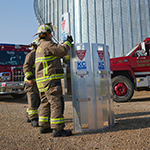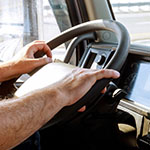Make a pre-trip vehicle inspection part of every fleet driver’s routine
Ensuring the safety and reliability of your vehicles is essential. While scheduled preventative maintenance by qualified technicians is crucial, safety-critical components can still fail unexpectedly between inspections.
To address this, consider implementing daily pre-trip inspections for your drivers. By using a checklist, they can identify any defects or issues that arise between scheduled maintenance, reducing the risk of accidents or roadside breakdowns. Regular checks empower drivers to keep vehicles in optimal condition and enhance overall safety on the road.
Fleet inspection checklist
While the pre-inspection checklist you adopt for your drivers may vary based on your vehicles and your company’s business needs, here are some typical items you may wish to include:
- Tire pressure: Temperatures changes of 10 degrees can cause tires to lose one psi of pressure. Low tire pressure affects stopping distance and gas mileage.
- Tire-tread depth: Insufficient treads increase risk of hydroplaning on wet surfaces
- Car lights: Headlights, turn signals, and brake lamps enhance visibility for drivers and pedestrians
- Windshield wipers: Excessively worn wipers reduce visibility in rain or snow.
- Cabin temperature: Properly functioning controls prevent physical stress and distraction.
- Emergency equipment: Ensure all emergency equipment is functional and fully stocked.
- Windshield glass: Address chipped or cracked glass promptly for safety and clear vision.
- Mirror swivel mounts: Ensure mirrors are properly tight and adjusted to cover blind spots and avoid collisions.
- DOT regulated vehicles: Familiarize yourself with driver inspection requirements for regulated vehicles.
Benefits of pre-trip inspections
Besides the role it plays in protecting people and property, having your drivers conduct routine pre-trip inspections can help you:
- Reduced delays: Prevent unexpected breakdowns.
- Early problem detection: Identify issues before they escalate.
- Profitability awareness: Spot fuel-consuming and tire-related problems.
- Reduction of Safety Measurement Systems (SMS) basic scores: Lower your Federal Motor Carrier Safety Administration (FMCSA) maintenance basic score.
Reinforce your company’s commitment to safety
If your organization has always made safety a priority, that will significantly influence drivers’ willingness to perform pre-trip inspections. To ensure a smooth introduction of your checklist to fleet personnel, consider the following steps:
- Educate supervisors and drivers: Explain the benefits of pre-trip inspections, including reduced downtime and easier repair scheduling. Highlight the importance of proactive maintenance.
- Design practical inspection forms: Collaborate with maintenance teams or local service centers. Create user-friendly forms tailored to your fleet and drivers’ tech proficiency.
- Provide feedback to drivers: Acknowledge their efforts and show how inspections lead to effective action. Consider regular updates on corrected items based on pre-trip notifications.
- Explore technological aids: Use telematics devices for predictive maintenance. Detect issues before they become critical.
Reference
1. Driving of Commercial Vehicles: Equipment inspection and use, 49 CFR Part 392.7.

 >
>

 >
>
 >
>